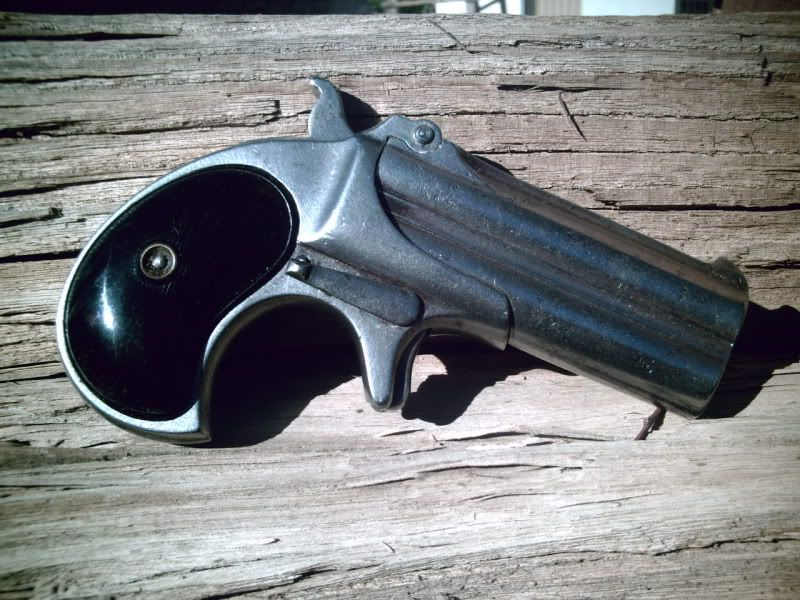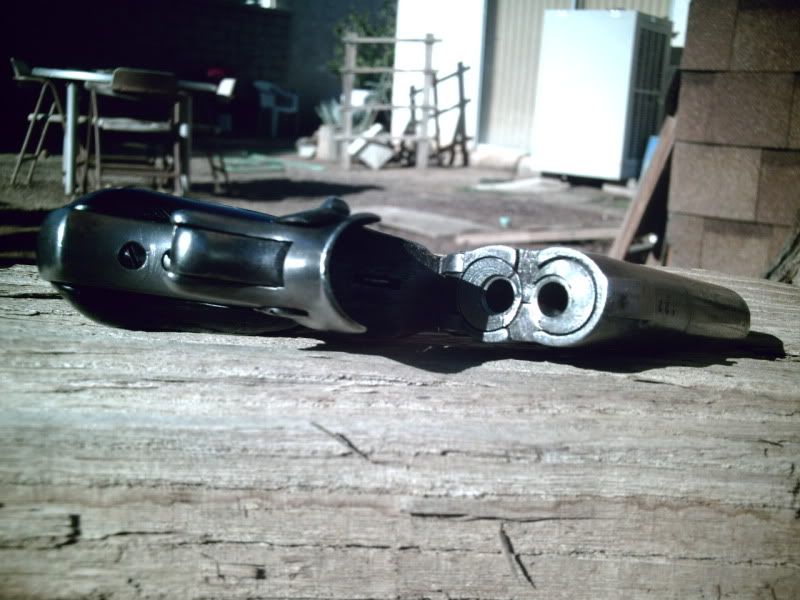You are using an out of date browser. It may not display this or other websites correctly.
You should upgrade or use an alternative browser.
You should upgrade or use an alternative browser.
.41 Rimfire derringer?
- Thread starter ZVP
- Start date
Andy Griffith
New member
It's likely 500-600 fps- real slow.
It killed by infection.
It killed by infection.
All I can tell you from personal experience is this: When I was about 12, my best friend's grandfather had an old Remington derringer and a partial box of .41 RF ammo (which probably had to predate WWII) which he kept in a cigar box in his bureau drawer.
One exceptional day, he allowed both of us to fire two rds each through it, mostly to short-circuit our curiousity so we wouldn't ever try to sneak it out on our own, I'm fairly sure.
From approximately 10 Ft., two of those four rds 'bounced' off of the telephone pole that was our target. The other two penetrated only slightly past the base of the bullet.
Granted, it was very old ammo (still loaded with BP, IIRC) but I feel safe in saying that IMO almost any .38 Spl. would certainly do better.
One exceptional day, he allowed both of us to fire two rds each through it, mostly to short-circuit our curiousity so we wouldn't ever try to sneak it out on our own, I'm fairly sure.
From approximately 10 Ft., two of those four rds 'bounced' off of the telephone pole that was our target. The other two penetrated only slightly past the base of the bullet.
Granted, it was very old ammo (still loaded with BP, IIRC) but I feel safe in saying that IMO almost any .38 Spl. would certainly do better.
HisSoldier
New member
The .41 rimfire fired a 130 gr. bullet with 13 grs. of bp at 425 fps with 52 ft lbs of energy.
Wow! Makes a .22 LR seem like a powerhouse by comparison. Speaking of which, I've always wondered how much powder the .22 shorts had. Lots of revolvers were sold chambered in .22 short as self defense weapons.
Looked it up; "The original loading was a 29 grain bullet and 4 grains of black powder. Bullet weight - 29 gr. / Velocity - 1,045 fps. / Energy - 70 ft.lb."
.22 LR; I wasn't able to tell if the LR ever had a BP loading. "Bullet weight - 40 gr. / Velocity - 1,082 fps. / Energy - 104 ft.lb."
Seems kind of odd then that the most frequent damage found on the old Remington double derringer was the hinge on the frame cracking.
The Doc is out now.
PS, I wish the new derringer manufacturers could make their guns more conforming to the shape of the old Remingtons. The old Remmies have the look of the one and only to them. The new ones look like a kid drew them after recalling seeing a Remmie.
The Doc is out now.
PS, I wish the new derringer manufacturers could make their guns more conforming to the shape of the old Remingtons. The old Remmies have the look of the one and only to them. The new ones look like a kid drew them after recalling seeing a Remmie.
Seems kind of odd then that the most frequent damage found on the old Remington double derringer was the hinge on the frame cracking.
Not really since they were made from cast iron.
Smokin_Gun
New member
My .41R Remington Derringer
I don't know what the veloscity is but I'll give you penitration results when my .41R BP ammo gets here :O)

This one fires with .22 shorts as it has inserts. I wanna pair to do full length of the barrels as I have the templates for them already.


I don't know what the veloscity is but I'll give you penitration results when my .41R BP ammo gets here :O)

This one fires with .22 shorts as it has inserts. I wanna pair to do full length of the barrels as I have the templates for them already.


HisSoldier
New member
Seems kind of odd then that the most frequent damage found on the old Remington double derringer was the hinge on the frame cracking.
I'll hazard a guess by saying that's probably from being opened too fast, even a little mass become a lot of kinetic energy if it's moving fast enough.
Mike Irwin
Staff
.22 Long Rifle was for many years, up past World War I at least, offered in black powder loadings. Late in the 19th century it also began to be offered with a BP/smokeless blend (one brand was known as Lesmoke), as well as smokeless powder.
The .41 rimfire round was loaded by at least one or two companies (Remington was one of them) right up to World War II, but was dropped for war production and manufacture was never resumed.
The .41 rimfire round was loaded by at least one or two companies (Remington was one of them) right up to World War II, but was dropped for war production and manufacture was never resumed.
Just a guess, as I really can't remember how the one example I ever fired worked, but if the extractor was actuated by a sort of camming action near the end of the barrel group's arc of travel (a la S&W No. 3, Webley et al) then that could well explain why so many well-used examples of the little derringer show cracking and/or breakage at the hinge.
If the barrel assembly had to be moved rather forcefully to ensure reliable extraction, then it seems logical to me that this weak point would be where the stresses would concentrate. If the frame was made of relatively 'soft' malleable iron instead of steel, then hysteresis could occur more readily and lead to failure along the stress lines.
If the barrel assembly had to be moved rather forcefully to ensure reliable extraction, then it seems logical to me that this weak point would be where the stresses would concentrate. If the frame was made of relatively 'soft' malleable iron instead of steel, then hysteresis could occur more readily and lead to failure along the stress lines.
The extractor is a thumb-operated lever that lifts the cases out of the chambers. The cast iron hinge ears crack because head thrust (chamber pressure X head area) is greater than tensile strength. They are pocket pistols, intended for self-defense, and it was probably not expected that a person would ever need to fire in self defense more than a few times during their lifetime.
JMO, the old Remington derringers probably got more of a workout from curiousity and thrill seekeers than people defending themselves.
JMO, the old Remington derringers probably got more of a workout from curiousity and thrill seekeers than people defending themselves.
Smokin_Gun
New member
The hinge broke from...
The Hinge Broke from people flipping the Derringers upright after releasing the lever to reload ... there was not enough chamber pressure to hurt these beefy lil' Guns in .41R or .22cal...
The Hinge Broke from people flipping the Derringers upright after releasing the lever to reload ... there was not enough chamber pressure to hurt these beefy lil' Guns in .41R or .22cal...
